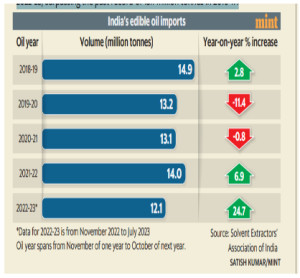Context:
India could end up importing as much as 15.5 million tonnes of edible oils in 2022-23, surpassing the past record of 15.1 million tonnes in 2016-17.
Possible Reason for record imports of cooking oil:
- Erratic Monsoon: Poor rains in major oilseed-growing states could lead to a production cut.
- For Example: Soya bean, which is the largest kharif oilseed, is in a poor state due to a prolonged dry spell in major producing states such as Madhya Pradesh and Maharashtra.
- Similarly, erratic rains have impacted the groundnut crop in Gujarat and Karnataka.
Why is India so dependent on imports?
- Home-grown soybeans, mustard and groundnut oil, among others, meet just 40% of requirements.
 Oilseed productivity of a tonne per hectare is less than half the global average, due to lack of access to the latest seed technology.
Oilseed productivity of a tonne per hectare is less than half the global average, due to lack of access to the latest seed technology.- Farmers also hesitate to grow oilseeds as they cannot compete with the flood of cheap imports and lack of price support mechanisms.
What steps has the government taken?
- Lowering of Import Duties: The government lowered import duties and urged retail brands to slash prices as global prices fell earlier this year.
- As a long-term solution, India is also pushing production of oil palm in 15 states with a focus on the North-east and Andaman & Nicobar Islands.
- Technology Mission on Oilseeds and other policy initiatives have helped India increase the area under oilseeds in India from 9 million tons in 1986 to 32 million tons in 2018-19, though not sufficient to meet the domestic demand.
- Several other initiatives like Oil Palm Area Expansion under Rastriya Krishi Vikas Yojana, increasing the minimum support prices of oilseed crops, creation of buffer stock for oilseeds, cluster demonstration of oilseed crops, etc are being implemented by the government to boost domestic production.
News Source: Livemint
![]() 12 Sep 2023
12 Sep 2023
 Oilseed productivity of a tonne per hectare is less than half the global average, due to lack of access to the latest seed technology.
Oilseed productivity of a tonne per hectare is less than half the global average, due to lack of access to the latest seed technology.